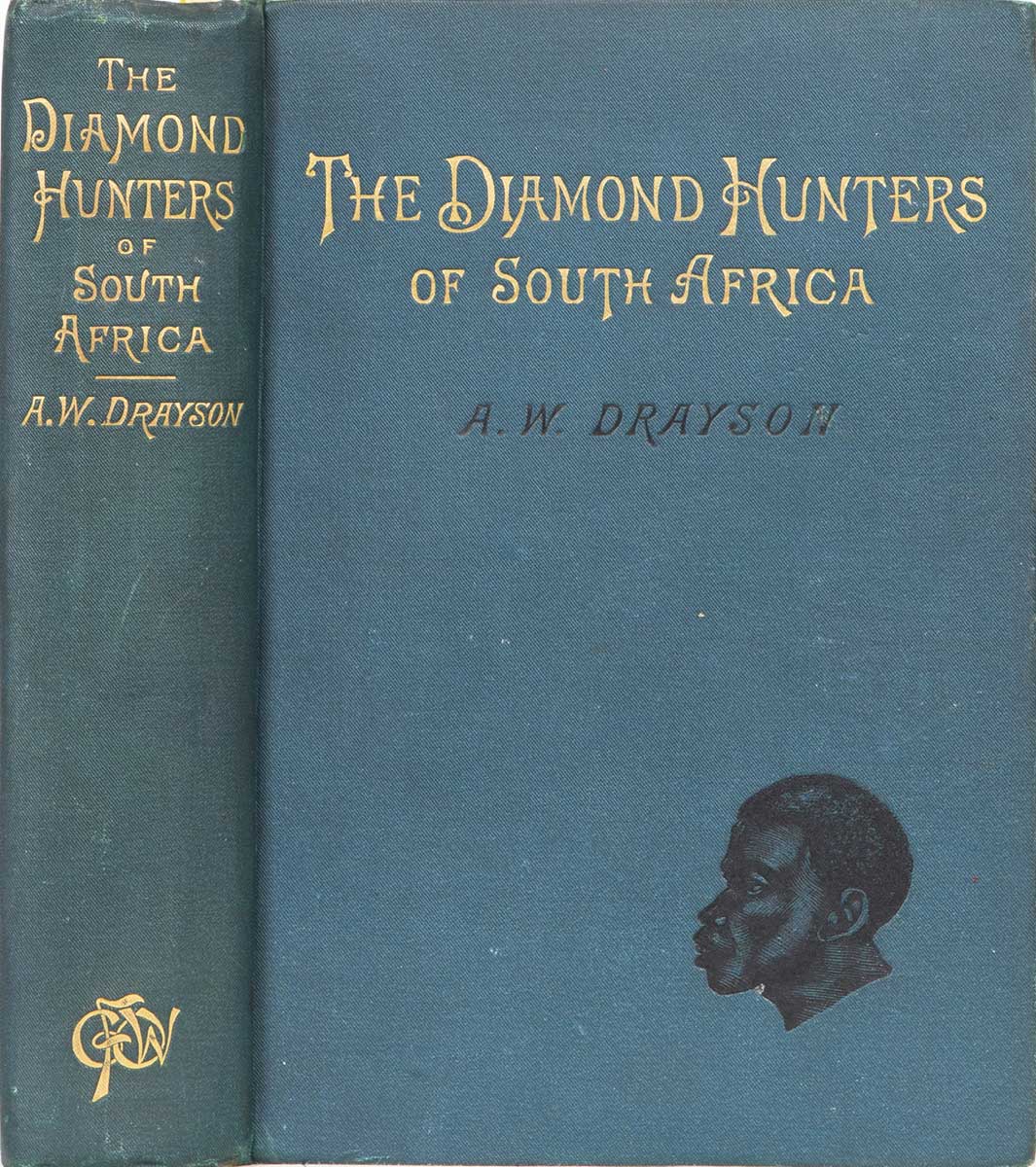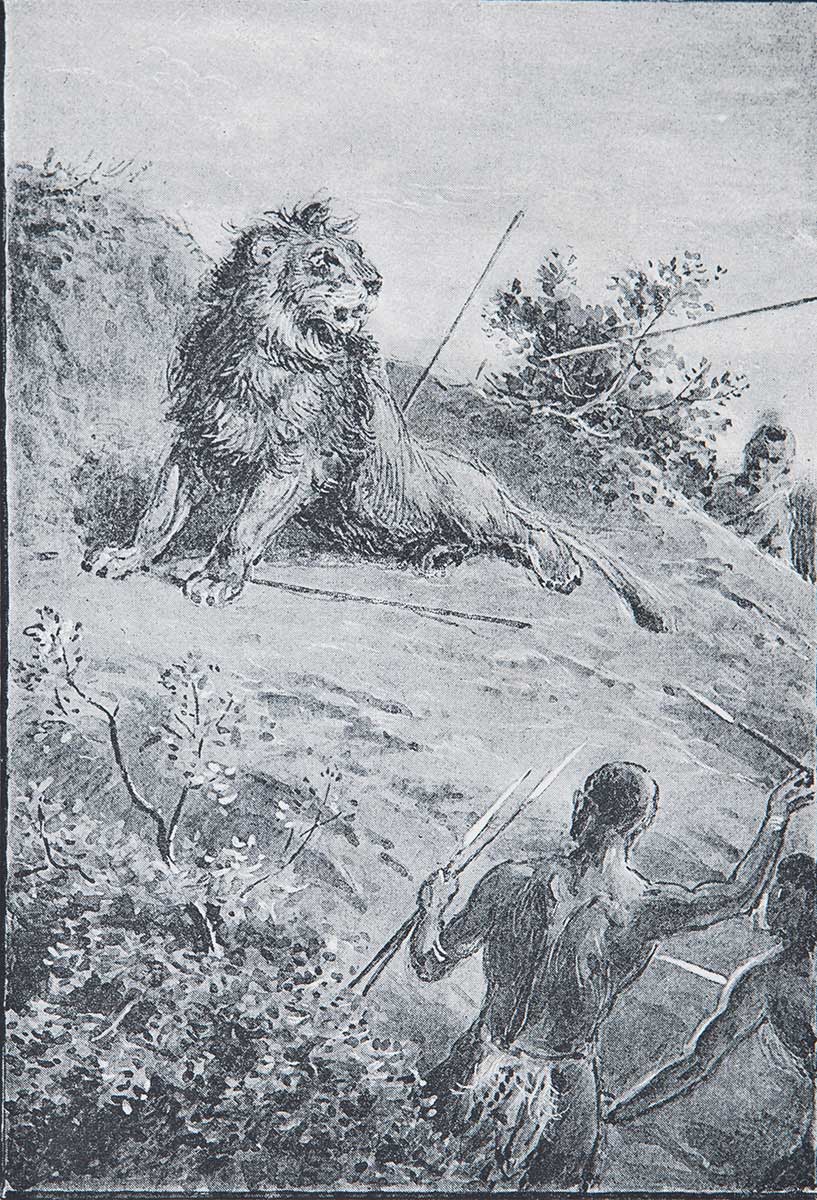The Diamond Hunters of South Africa
 Attacked by a Lion: It was the fourth night that they were camped out, and when they were near the Imvoti River, that the party fully realized that there were in a thoroughly wild country. So camp was set up with the usual precautions again attacks from wild animals. A large fire had been made for cooking purposes, and had been allowed to die out when a sound was heard from the distant rocks. It was a new sound to John and George but Kirk at once pronounced it to be the roar of a lion. Spot (our dog) seemed also to know as the hair on his back stood up. Showing his teeth, he stood listening, evidently aware that his most deadly enemy was in his vicinity.
Attacked by a Lion: It was the fourth night that they were camped out, and when they were near the Imvoti River, that the party fully realized that there were in a thoroughly wild country. So camp was set up with the usual precautions again attacks from wild animals. A large fire had been made for cooking purposes, and had been allowed to die out when a sound was heard from the distant rocks. It was a new sound to John and George but Kirk at once pronounced it to be the roar of a lion. Spot (our dog) seemed also to know as the hair on his back stood up. Showing his teeth, he stood listening, evidently aware that his most deadly enemy was in his vicinity.
Additional precautions were taken to collect more firewood and to build a thick fence of bushes around the camp. It was also agreed that one of the three white men should take watch, keep up the fire, and be ready to defend camp if the lion came near. It was unlikely that the lion would come early in the night. Nevertheless, each man was assigned a time for his watch.
Camp was near a little stream, some 50 yards from the bush. Country on one side was open and the oxen that dragged the supply wagon had a good meal of grass in this open space. But previous to sunset the animals were fastened so that they would not stray during the night. Though not formidable, or likely to attack man, there were hyenas in the country and they would attack a lone ox. Hyenas would seize an ox by its flank and hold on with their powerful jaws until a piece was torn from the animal’s body. There is no animal in existence whose jaws are more powerful than those of a hyena. It can grind up the legs of an ox as easily as a dog will digest a chicken bone. But they have never been known to attack a man.
George undertook his watch, with Spot curled up beside him. The dog seemed to be aware that there were enemies about so Spot slept with one eye open and one ear on the alert. The night was dark and it was difficult to see beyond two yards. Thus the ears would yield the most information. Various sounds broke the stillness of the night: jackals, the oxen moaning, night birds circling, and then a lone wolf. In response to the latter Spot growled.
George kept up the fire so as to gain as much light as possible. But often the flame would dwindle and only red hot embers gave a glow to surrounding objects. After about two hours, when the fire was giving little light, the oxen began to move uneasily, the horses began to snort, and Spot rose to his feet, his tail between his legs, teeth showing, and he stood trembling with excitement. These were the times that tried men’s nerves. Most men would have called their two companions. Instead George stayed more watchful than ever, quietly adding some wood to the fire and gazed into the distance and darkness trying to discover what creature had approached the camp. Suddenly he saw two bright shining objects and he knew they were the eyes of either a leopard or a lion.
George did not think a leopard would be sufficiently daring to approach so close to the camp. He concluded that the lion had come into the neighborhood to see what he could carry off for supper. Raising his gun he fired at the two bright lights but the darkness was so great that he could not take a sure aim. To fire in uncertainty might lead to dangerous results. Unless he killed the lion, he would run the risk of being attacked with only one barrel of his gun loaded.
Experience teaches, and George thought of something that had not occurred to him before, i.e. that he should have a second loaded gun within reach. But under the critical condition which prevailed he dare not move. The lion was crouching 30 yards away and every so often George heard the swishing of the lion’s tail, just as a cat moves its tail when about to spring on a mouse. There was no other movement. Two bright lights remained motionless, showing that the animal’s head was quiet. Would the lion spring on him, or on the oxen or the horses? That was the question George kept pondering. It was impossible to say what the lion would do. But one thing was certain: the monarch of the desert must be very much in want of food, or he would not have ventured so close to his most dreaded enemy, man.
Once or twice George raised his gun to endeavor to obtain good aim at the lion, but the darkness baffled him. Suddenly, however, the lion, which had been crouching, rose to its feet and came rapidly forward towards the bushes which had been placed near the wagon. Seeing this, George took rapid aim at the animal’s forehead and pulled the trigger.
In those days percussion caps were used (breechloaders and pin cartridges were unknown) and as a heavy dew had been falling, the caps had become damp. It was not until after this adventure that George learned that to guard against a gun hanging fire it was necessary to dip the caps into some grease, as a to have a thin film around the opening before placing these caps on the nipple of the gun (and thereby to keep out the damp). The effect of the dew in this instance was to cause the gun to hang fire, and the bullet which, had the weapon exploded instantaneously, might have struck the lion between the eyes, whistled harmlessly over its head. Uttering a savage growl the lion bounded away. Meanwhile Kirk and John were beside George inquiring as to what happened.
“It is lucky you did not wound him,” said Kirk. “Had you done so without killing him, he would have been on you in an instant. But I believe he will pay us another visit in an hour or so.” George suggested that two guns should be within reach during “watch time” and also stated that the oxen, horses and Spot would give warning when the time came.
“Call me if he comes,” said George. “I don’t feel very sleepy, and shall be up in a second.” But the night passed without another visit from the lion and the next day the men continued their journey. They wanted to reach a resting place where they could have sport, but away from the wagon trail. Taking Spot with them, they mounted their horses and rose to a Kaffir kraal about two miles from where they camped the previous night. On reaching the kraal they made inquiries about the lion and were told that it had been nearly a month in the vicinity and had killed several cows and calves and that after dark no Kaffir dare leave the enclosure round the huts.
During the day the lion lay in a rocky ravine, in which there was very long grass. It was about five miles from the kraal. Arrangements were soon made with about a dozen men to track the lion for John, George and Kirk intended to shoot it, thus freeing the Kaffirs from its depredations. This announcement delighted the Kaffirs. Armed with assegais and shields they led the men away to the ravine. Several Kaffir dogs ran in front, while Spot, seeming to think himself superior to these curs, kept near his masters and took no notice of the other dogs.
 When the party came near the ravine they moved along in silence, signaling by hand giving information that is usually conveyed in words. The tracks of the lion were quite fresh and led into the ravine, but there were no footprints leading out. Thus it was assumed that the lion had been tracked to his lair. John separated from George and Kirk and rode on one side of the ravine, while George remained on the other. Spot elected to stay with George. From the behavior of the Kaffir dogs, it was evident they knew the lion was near. Their tails were curled up under their hind legs and their lips drawn up to show their teeth, while the hair on their backs bristled up and really stood on end. At the slightest rustling of the reeds or grass, the dogs rushed away and did not stop until they had gone 40 or 50 paces. Probably these dogs had never seen a lion or had an experience of the power of such an animal. But their instinct seemed to have taught them how dangerous it was to come within reach of such a creature.
When the party came near the ravine they moved along in silence, signaling by hand giving information that is usually conveyed in words. The tracks of the lion were quite fresh and led into the ravine, but there were no footprints leading out. Thus it was assumed that the lion had been tracked to his lair. John separated from George and Kirk and rode on one side of the ravine, while George remained on the other. Spot elected to stay with George. From the behavior of the Kaffir dogs, it was evident they knew the lion was near. Their tails were curled up under their hind legs and their lips drawn up to show their teeth, while the hair on their backs bristled up and really stood on end. At the slightest rustling of the reeds or grass, the dogs rushed away and did not stop until they had gone 40 or 50 paces. Probably these dogs had never seen a lion or had an experience of the power of such an animal. But their instinct seemed to have taught them how dangerous it was to come within reach of such a creature.
The Kaffirs, who kept together in groups of three or four, commenced throwing large stones into the ravine, while John and George remained quiet on the elevated ground ready for a shot should the lion break cover. They remained watching for scarcely a minute, when George saw the lion moving up the side of the ravine on which he was stationed. The lion was crouching low and sneaking along just as a cat does when it is out on a thieving expedition.
Just as George raised his gun to fire, the lion stopped, apparently to listen, and thus gave the hunters a better chance of hitting him. George, taking good aim, fired and almost at the same instant, John’s gun was discharged. Spot rushed forward in spite of being called back by George, who feared that the brave old dog would instantly be killed. Meanwhile the Kaffirs who had caught sight of the lion, rushed boldly towards it and there seemed every chance of some lives being lost. A singular sight emerged. The lion, roaring savagely, sat up as it were on its front legs, while its hindquarters remained helpless.
The Kaffirs seemed to guess what had happened and approached the lion within 30 paces while hurling assegai after assegai into its body. George warned the Kaffirs to stand clear and sent a bullet into the lion. It entered right behind the shoulder and the lion rolled over dead. To examine the cause of the lion’s inability to move was George’s first proceeding. He then discovered that he had made one of those singularly fluky shots which many sportsmen who have killed large game have experienced. His bullet hit the lion in what we called the small of the back, broke the backbone so that the hindquarters of the lion were paralyzed, and rendered the lion unable to move except by dragging his hindquarters with only the help of his two front legs. Had the bullet struck three or four inches lower it might have passed right through the lion, but would not have stopped him. And if the bullet had been only one inch higher, it would have missed the lion altogether.
The Kaffirs, using their assegais, skinned the lion while John and George secured the teeth and claws. The Kaffirs were told to clean and peg out the lion and have it ready for when the hunting wagon returned from Zulu country. Meanwhile the return of two successful hunters to the kraal from which they had set out on their hunting expedition was a sort of triumphal march. Their praises were sung by the attendant Kaffirs while every kraal they passed supplied dozens of men, women, and young girls who listened to the account of the hunt and expressed their admiration for the skill and bravery of the young white chiefs.–By A.W. Drayson selected and Edited by Ellen Enzler-Herring of Trophy Room Books


